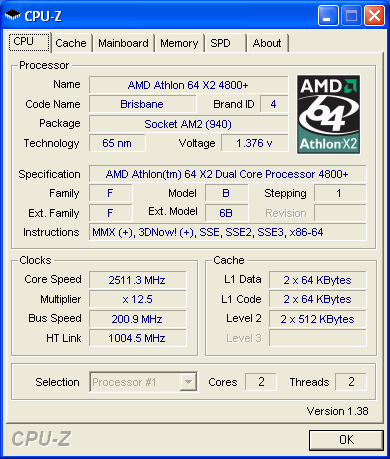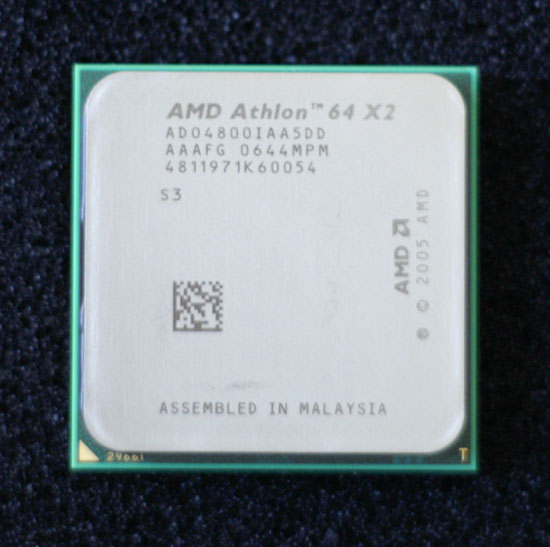AMD's 65nm Preview Part 2 - The Plot Thickens (Updated with Information from AMD)
by Anand Lal Shimpi on December 21, 2006 12:12 AM EST- Posted in
- CPUs
Updated: Page 3 has been updated to include an official AMD response on the Brisbane performance issues we've been seeing. AMD confirmed an increase in L2 cache latency in order to support a move to larger cache sizes in the future, which may or may not happen. The rest of the article remains unchanged.
Last week AMD sent us samples of its first 65nm processors, codenamed Brisbane, and it was a step towards being competitive with Intel again. The 65nm shrink yielded AMD's most efficient desktop processor to date, but it's still a far cry away from what Intel is able to accomplish with its Core 2 processors.
Although they won't be available until sometime next year, a closer look at AMD's 65nm lineup reveals an interesting fact. Until recently, AMD would differentiate between subsequent model numbers by clock speed and cache size, alternating between the two. So while the Athlon 64 X2 4600+ and 4800+ both ran at 2.4GHz, the latter had twice the L2 cache per core at 1MB. After Intel's Core 2 launch, AMD killed all non-FX 1MB L2 parts, resulting in a processor lineup that was mostly segregated according to clock speed. (Of course they then added the X2 5200+ and 5600+ back into the mix....) With the move to 65nm, AMD is once again introducing model numbers that it had killed off before, but without playing with L2 cache sizes; instead, AMD is breaking with recent tradition and implementing non-integer clock multipliers for these "new" in-between speeds. The table below explains it all:
| CPU | Clock Multiplier | Clock Speed |
| AMD Athlon 64 X2 5000+ EE | 13.0x | 2.6GHz |
| AMD Athlon 64 X2 4800+ EE | 12.5x | 2.5GHz |
| AMD Athlon 64 X2 4600+ EE | 12.0x | 2.4GHz |
| AMD Athlon 64 4400+ EE | 11.5x | 2.3GHz |
| AMD Athlon 64 X2 4000+ EE | 10.5x | 2.1GHz |
We didn't mention this in the original article, but all of AMD's 65nm CPUs are considered to be Energy Efficient (denoted by the letters EE in the table above). With its 90nm chips, AMD specifically selected lower voltage parts to be labeled as Energy Efficient, but right now all 65nm parts are. For the sake of simplicity, especially as we compare to older EE parts, we will simply refer to these chips as 65nm chips.
Note that the 65nm 4800+, 4400+ and 4000+ all use non-integer clock multipliers, a first for the Athlon 64 line. The implications for the end user are relatively minor, although it does mean that the model numbers will translate into more consistent performance graduations. In the past, having two chips running at the same clock speed but with different cache sizes meant that one would be faster only in those applications that could use the extra cache.

Despite support for non-integer clock multipliers, all AMD chips still only support integer memory dividers, meaning that only CPUs with even CPU multipliers can run at DDR2-800. All odd clocked (5000+) and half-clocked processors (4800+, 4400+, 4000+) run at a slower than DDR2-800 speed, even when set to DDR2-800 in the BIOS. AMD wouldn't discuss whether or not this would be addressed in the future, but if it is we'd have to wait for at least another silicon revision.

By now, none of this is new information, which brings us to why we're here today. In our original 65nm article we noticed a performance disparity between AMD's 65nm and 90nm processors, yet we had no official response from AMD as to why; today we have that answer. At the same time, we wanted to take a look at one of the half-multiplier chips and add it to our performance and power graphs, not to mention include some lower cost Intel CPUs per your requests. We've also got some more insight into the die sizes and power consumption figures we reported in our last article. In a sense, we're tying up loose ends with this piece, and shedding more light on AMD's 65nm cores than we originally did in our first, quick preview.










52 Comments
View All Comments
mino - Thursday, December 21, 2006 - link
RD580 is even lower than P965 ... NF i680 and NF 590 are both power hogs.They are not ideal (as well as 8800GTX) for power-comparison but they are BOTH pretty hot in their respective markets.
JackPack - Thursday, December 21, 2006 - link
Where did you pull that "90%" figure out of? If a PC is idling more than 90% of the time without going into standby or hibernate, the user is an idiot.Hardly any PCs operate at pure idle. No real-time antivirus scan, no file indexing in the background, no email autochecking, no IE7 open with at least one Flash ad, etc.
mino - Thursday, December 21, 2006 - link
Well, how would you like Your PC to standby(not to mention hibernate) while typing or listening to MP3's ???At these moments (most common usage of a PC BTW) the average CPU use is 1% to 5%.
... ;-)
mino - Thursday, December 21, 2006 - link
Sorry fo no reading the second sentence, the first one was too crazy to continue reading back then ... So"Wwhat is "pure idle" ? CPU is able to go between C-states in (micro-to-mili)seconds, How fast can you type?
AV checking? when you type? to check whether one is coding some exploit? :)
Backgroung file-idexing? no thanks, I prefer on-MY-demand search to on OS's demand.
Email-autocheck? done in 0.1s at 5% CPU used, once in 5 minutes...
IE7? no, thanks, not required for Windows Update...
Flash ad open? no, thanks, flash enabled only for reasonable sites or the ones requiring it(a few). Also, an usuall Flash is only up to 10% K8 core at 1000MHz
etc.
You may ask, why X2/C2D then when no background BS? Well, as of now I'm pretty happy with my Q1 install of Win2k on A1.66/512M/R9200/dualUXGA backed up by ~ 2TB NAS(with 3G P4C :). The system is more responsive than nearby mate's X2/1G with all that "necessary" bloat you mentioned.
Me having loaded 50+ webpages and 5-10 active apps a common sight...
mino - Thursday, December 21, 2006 - link
Now I figure, maybe, maybe, the average PC has become so bloated and unmaintained as to not even be able to put CPU's to Sleep states?I have not seen this except outrageously malwared machives yet. However my sample size may be unrepresentative a bit too much.
If it is so, to abandon PC and return to calculus at primary may be a good idea.
JackPack - Thursday, December 21, 2006 - link
That's not idling.Nice strawman, BTW.
mino - Thursday, December 21, 2006 - link
Well, wrote "90% of time" ... did not write how big the chunks of time are - they vary pretty much from tens of microseconds to tens of minutes.P.S. that post of mine from 10:19 was written before yours 10:13.
JackPack - Thursday, December 21, 2006 - link
...and AMD wants to accelerate their transition to 45nm? Maybe they have a magic lamp somewhere in their Sunnyvale office.Seems like the increase in L2 latency might be a contingency plan for GHz or more cache, in the event Agena doesn't meet its Q3 target.
Locutus465 - Thursday, December 21, 2006 - link
I upgraded to an S939 X2 earlier this year, so I'm going to be out of the serious upgrade market for a while (might pick up a better CPU or graphics card that's about it). So personally I'm waiting for K8-L and co-processors to see how things shake out. I do have to say I had hoped better from AMD, but after 3 years of dominance I think a stumble like this is just what they need to get them back on the war path of innovation.peldor - Thursday, December 21, 2006 - link
AMD's vision of coprocessors is 2009 stuff. You'll be out of the market a long time if you're waiting on that.